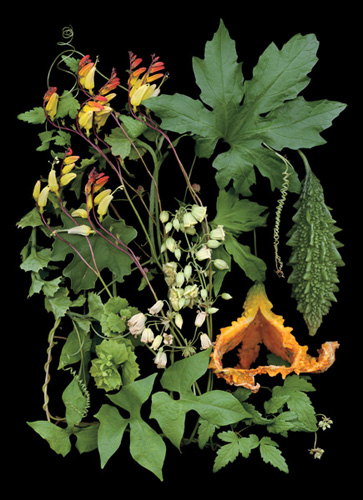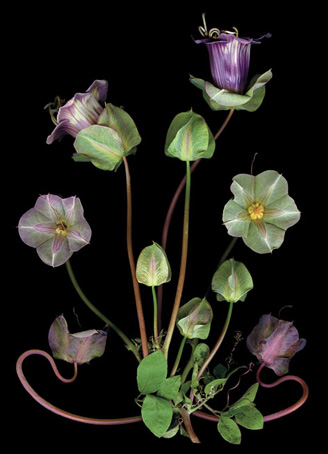
Summer vines include clockwise from top left: multicolored Mina lobata; bitter melon (Momordica charantia) with split fruit that has dropped its scarlet seeds; cream and yellow-green Clematis rehderiana; snake gourd Trichosanthes kirilowii, which also bears frilly white flowers.

Consider the various ways vines climb. Knowing the ways that these plants get where they want to grow can help you choose the right support, and often, the right vine.
Some plants wind their growing shoots around anything—whether a sturdy branch or a length of string. The terminal shoot circles the air, searching for assistance. When it “feels” something, cells on one side of the stem grow at an accelerated pace, which causes the stem to wind. Wisteria vines and beans climb using this seek, discover, and twine method.
Plants like bougainvillea use vigorous new shoots to thread through older stems to hang on to. Roses also grab older canes and on to trellises or fences with their thorns. Other vines, passionflowers for instance, have tendrils. When these modified leaves come in contact with something, they wind around it and then corkscrew to pull the stem in close. The spring tendril also acts as a shock absorber in the wind. Clematis leaf stems behave like tendrils bending around a wire or string to support the vine.
Still other vines have fingertip-like disks that glue themselves onto a surface. Boston ivy attaches with these disks called “holdfasts.” True ivy, Hedera species, and climbing hydrangea, for example, have small rootlets called adventitious roots that actually grow into the cracks between bricks, onto the surface of stucco, or into tree bark or porous wood shakes to hold on. Vines that grab with holdfasts or rootlets do not make good choices for covering anything besides dry stone walls and will not climb wires or other slender props.
If you are considering a vine to adorn a building, select a safe one that won’t pull down the siding. In any event, provide a structure for a vine that will stand several inches in front of the building. Some vines are flexible enough to allow you to lower them when the house needs washing or painting. I’ve seen some nice trellises that are hinged at the ground, and fold down for maintenance.
With diligent pruning, you can encourage a vine like wisteria to grow as if it were a tree over a sturdy umbrella-shaped form—into a topiary called a standard. But don’t be surprised if in response to hard pruning one of the more vigorous varieties of W. floribunda or W. sinensis sends up a shoot in the lawn—some fifty feet away.
The Art Nouveau-like annual cup-and-saucer vine (Cobea scandens).

Magnolia Plantation and Gardens in Charleston, South Carolina, is home to local native Wisteria frutescens and the more vigorous W. sinensis (shown), which has naturalized through a property that has been in family ownership since 1679.